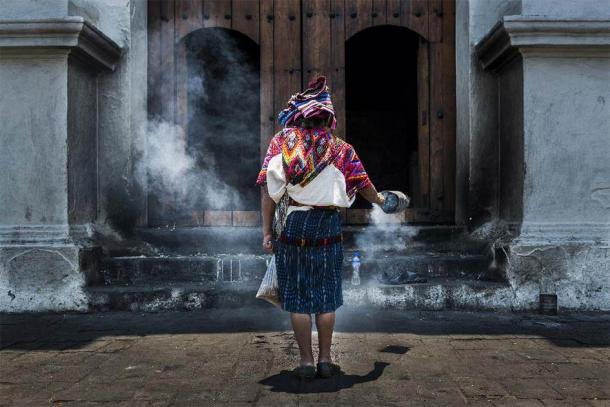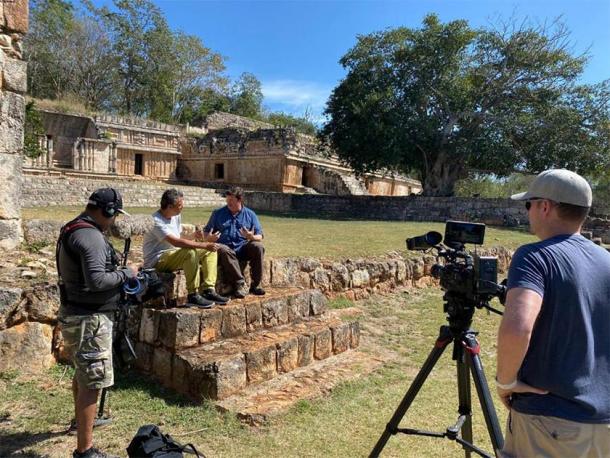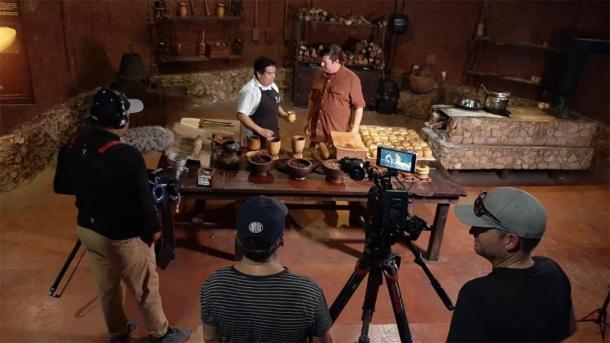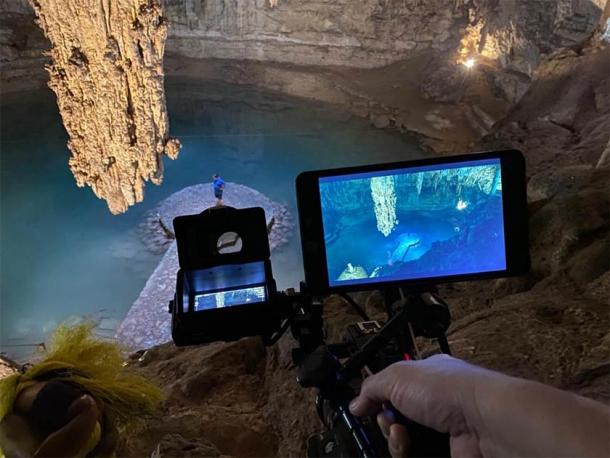
The Maya People Still Have So Much to Teach Us
There’s overdue pushback these days on the notion that civilization began in the Americas when Columbus “discovered” the New World in 1492. In fact, the Maya people built one of the world’s most sophisticated ancient civilizations many centuries before the Spanish arrived in Mesoamerica in 16th century. It was a complex civilization that pioneered many advances in engineering and science.
Another myth that deserves debunking is that the Maya people are gone, an ancient line that has long since died out. In fact, the Maya are still very much with us today. By some estimates, there are about 15 million Maya people, though it’s difficult to get a precise count since the Maya’s experience as a people has made them understandably reluctant to volunteer details to census-takers.

Maya woman performing a ritual in front of the Santo Tomás church in the town of Chichicastenango, in Guatemala. (PeekCC /Adobe Stock) By some estimates, there is a population of about 15 million Maya people today.
Although the Maya people are an active and vital part of our present, their history has much to teach us, including lessons about the way humans interact with the environment and the implications for how civilizations rise and fall. From public works to government to art to community and character, there’s still much more to discover about the Maya’s past and present.
Archaeological Treasures Hiding in Plain Sight
In archaeological terms, we’ve only scratched the surface of the Maya civilization. Just this summer, researchers revealed a 3,000-year-old Maya complex discovered using LiDAR technology “hiding in plain sight” in Mexico’s Tabasco State. With a platform and buildings that exceed the volume of the largest Egyptian pyramid, it’s the oldest and largest structure discovered so far in the Maya region.

In archaeological terms, we’ve only scratched the surface of the Maya civilization. (Dr. Edwin Barnhart, Director of the Maya Exploration Center/Great Courses Plus)
The archaeologist who discovered that site, Takeshi Inomata, a University of Arizona researcher, speculated that no one had noticed it before because it’s so huge that it’s difficult to comprehend the scale of it from the ground level. Dr. Inomata has found more than two dozen previously unknown Maya sites using a LiDAR map published by Mexico’s National Institute of Statistics and Geography.
In addition to finding new sites for archaeological study, LiDAR can help archaeologists discover more about sites that are already under excavation. Causeways leading to sites that may have had ceremonial uses and agricultural terraces can be difficult to see from the ground. But detecting their presence and measuring dimensions via LiDAR can provide important new information about the ancient society.
Mapping Maya Ruins to Learn More About Ancient Maya Life
An earlier survey that I led, the Palenque Mapping Project, centered on the Maya ruins of Palenque, Chiapas, Mexico, and it also tells us more about how the ancient Maya lived. Abandoned between 850 and 900 AD, the site had been known to archaeologists for more than a century, but previous work focused on Palenque’s ceremonial center. My mapping project was designed to improve understanding of life in Palenque’s outer regions.
My mapping project revealed that Palenque was among the most urbanized cities of the Maya Classic Period. The population wasn’t as large as other sites of the era — Palenque had about 7,500 inhabitants, whereas Teotihuacan had more than 200,000 people — but the settlement density was the second highest ever documented in the Maya region. This led me to conclude that the Maya people of the period were practicing a high level of cooperative living, at least by the Late Classic period.

Palenque mapping project. (Dr. Edwin Barnhart /Maya Exploration Center)
I found evidence of social diversity in Palenque that corroborates proof of social diversity found throughout the ancient Maya world due to the sophistication of the building projects, art, historical records, etc., of that time. I also found ceramic and masonry workshops and public works in the form of terraces and canals to guard against erosion and flooding in Palenque. The latter suggested to me a civic-mindedness that is still very much in evidence among modern-day Maya people.
Council of Deities Reflected in Present-Day Communitarian Politics
The supernatural realm of the Maya included numerous deities who were thought to influence all facets of life. Depictions of Maya rituals in popular culture tend to focus on the most sensational part of the ancient Maya practices: human sacrifice. Human sacrifice was common throughout Mesoamerica at the height of ancient Maya civilization.
But Maya religion was and is more complex than it is sometimes portrayed. Ancient rites included offerings of food, pilgrimages, theatrical productions — and even ritual ball games with spiritual themes. Chichén Itzá, one of the largest ancient Maya cities and currently an active archaeological site and popular tourist attraction, is home to an enormous open air ball court built by the Maya people.
One notable aspect of the Maya religious pantheon is that it is similar to a council — a representational body. We don’t know if there was a chief god, but the artwork created at Maya sites over the centuries suggests a more communitarian arrangement. That same communitarian mindset is reflected in politics practiced at the community level by present-day Maya people.
Ancient Culinary and Pigment-Making Techniques Inform Modern Methods
In addition to significant achievements in astronomy, architecture, and representative government that still echo through the centuries, the Maya have also had a profound influence on world cuisine. And in creating enduring art, the ancient Maya mastered chemical processes using methods that stumped modern scientists for decades.
Maize — also known as corn — is the food most commonly associated with the ancient Maya, and it still plays an important role in the diet of Maya people living today. Maize gods in both male and female form are prominent in the ancient Maya pantheon because of the importance of the staple crop to the sustenance and survival of the people.
Historians believe corn was domesticated in present-day Mexico nearly 10,000 years ago. Cultivation has since spread worldwide. But maize isn’t the Maya’s only contribution to world cuisine: both chocolate and vanilla were among the abundance of foods Europeans took home from the New World. In this century, modern chocolatiers looked to Maya traditions to refine their products, closing the circle.

The Maya have also had a profound influence on world cuisine. Modern chocolatiers looked to Maya traditions to refine their products. (Dr. Edwin Barnhart, Director of the Maya Exploration Center/Great Courses Plus)
Maya traditions are also instructive in creating dyes and paints. “Maya blue” is a vibrant hue found on ancient murals and pottery, a pigment derived from the indigo plant and minerals found in clay. But the process used to turn those ingredients into a stable, fade-resistant paint was a mystery for many years, until Field Museum researchers determined that incense used in rituals formed the binding agent.
Incorporating Old Traditions into New Rituals
While Europe was enriched with new foods and other resources taken from the Maya when the Spanish began their conquest of present-day Mexico, the Maya people (and humanity in general) were impoverished by the conquerors’ destruction of centuries of accumulated civilizational history and artifacts, leaving gaps in historical knowledge that today’s researchers are still trying to bridge.
To cite just one example, in the 16th century, a Catholic priest on a mission to convert the Maya, Diego de Landa, burned incalculably valuable books and destroyed thousands of images in an attempt to sever the Maya people’s ties to their deities and religious rituals. His efforts were only partially successful; modern-day Maya often practice a form of Christianity that incorporates traditional Maya rituals.
It’s still possible to explore sites the Maya used for contemplation and ceremonies in Mexico today, where visitors can find echoes of the earliest music and art from the ancient Maya civilization. One such place is the Loltún Caves, which contain 10,000-year-old handprints and cave paintings as well as natural columns that can be struck to produce a musical tone.
- What Happened to the Maya?
- An Ancient Maya City Founded by a God and Conquered by a Death Cheating Despot
- The Maya Codices: The Precious Remaining History of an Eradicated Civilization

It’s still possible to explore sites, such as the Loltún Caves, which the Maya people have used for contemplation and ceremonies. (Dr. Edwin Barnhart, Director of the Maya Exploration Center/Great Courses Plus)
Cultural Resilience in the Face of Adversity
New LiDAR technology and old-fashioned human exploration will undoubtedly continue to uncover new Maya archaeological sites, and researchers will persevere in piecing together the history of the region. Each new piece of the puzzle makes the picture of one of the world’s most sophisticated ancient civilizations more complete.
Today’s Maya people are reclaiming their rightful place as the heirs to that ancient civilization. They deserve the dignity and autonomy they’ve earned by maintaining their centuries-old traditions. And as visitors meet the modern-day Maya people (in person or through video expeditions recently launched by The Great Courses) and experience their warmth and generosity, our shared bonds as citizens of this planet are strengthened.
Exploring Maya history sheds new light on the evolution of human understanding in a variety of fields, including politics, art, agriculture, architecture, and spirituality. But getting to know the Maya people today is a cultural treasure in its own right, a study of human resilience in the face of adversity. The Maya are great teachers with a compelling lesson — and there’s still so much we need to learn.
Top Image: The Maya people still have so much to teach us. Source: Robin / Adobe Stock
By Dr. Edwin Barnhart
















Comments
Hello Dr. Barnhart,
You mentioned Columbus and America's not being considered Civilized till Columbus arrival so I have this to say...
Growing up African American one has to learn of The Black Experience in America, and through these Lessons of the past you also come to learn about The Beliefs and ideas that motivated the whole evil business that got started in the first place.
It came down to the principle of skin color, the good ole (and I'm being sarcastic with this point) Noah Cursed Ham, and who was Civilized and who wasn't considered to be a Civilized people.
That's what I see when I study about Columbus, Cortez, and Pizzaro in Peru against The Incan Empire. These supposed explorers deciding that these people weren't Civilized according to their Cultural Ideas of what Civilizations was supposed to be Columbus, Cortez, and Pizarro Slaughtered Human Beings because of their Racist Idea of Civilized when They were the ones Not Civilized.
How can one not look upon The World's Global Pyramids and not see Civilization? All of the places where Pyramids have been discovered and explored displayed their Science & technical feats.
I remember when I read the Epic Poem Gilgamesh it really bothered me on how that wild man living one with nature he was doing great right until quote Progress and Civilization Tamed him and made him like everyone else.
He would have died eventually that Wildman who ran with the animal's in Gilgamesh but, his interaction with people hastened death to come too him much faster.
In the same vain when Cortez got to Mexico after uniting with The Aztecs Enemies they Outlawed The Aztecs and other Indigenous Populations in The New World from taking so many Bath's. Bath's really Spain?
That made The People UnCivilized?
Great article Dr. Barnhart I enjoyed reading this piece greatly and I look forward to reading more of your articles until next time Goodbye!
Hello Pacman 7331,
The only History I'm aware of Catholic things being destroyed, I believe happened in Ireland.
I think if I'm wrong on this subject some body will definitely correct me. I believe when Britain took over Ireland for the Final Time and stayed and never left The British Empire; at that time, had Outlawed Catholicism, it's possible they did destroy Their Holy Book's in Catholicism.
I do know that in The United States of America, in 1945, 45,000 Ku Klux Klansmen marched in Washington, D.C. where THEY Declared their Hatred for Blacks, Irish Catholics, and Jews it was the largest Ku Klux Klan gathering recorded in 1945.
Honestly I didn't get the whole Irish Catholic deal with The Klan I'm unaware if They destroyed any Sacred Catholic Books are writings but since they Fire Bombed Black Churches and Houses then it wouldn't surprise me if THEY Fire Bombed any Catholic Churches.
Goodbye for now Pacman7331!
“in the 16th century, a Catholic priest on a mission to convert the Maya, Diego de Landa , burned incalculably valuable books and destroyed thousands of images in an attempt to sever the Maya people’s ties to their deities and religious rituals”.
And yet we haven’t done the same yet to the catholics. Why do Europeans or anyone continue to tolerate this blight on the world?